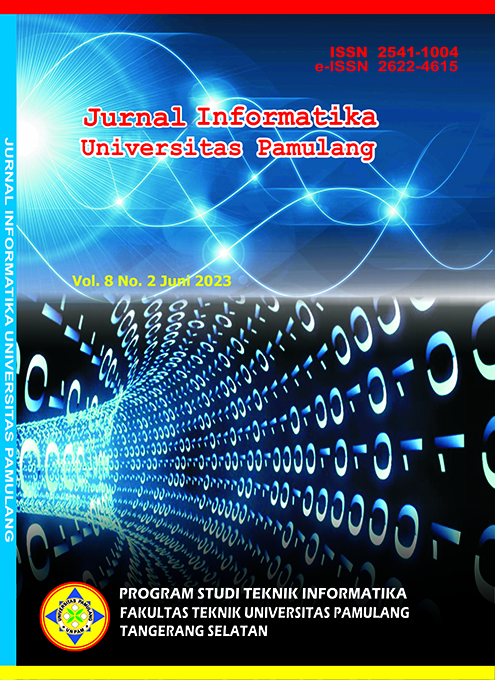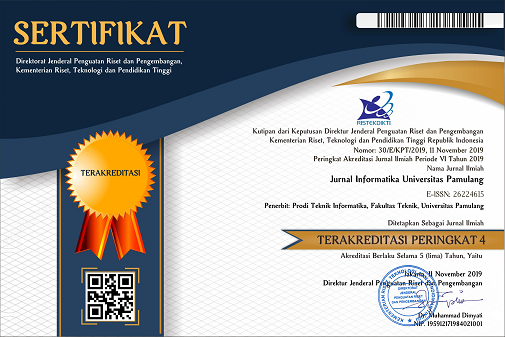Design and Development Early Detection of Neurodegenerative Disease Using IoT Technology
DOI:
https://doi.org/10.32493/informatika.v8i2.32842Keywords:
Neurodegenerative disease, Parkinson disease, Internet of thing, Healthcare systemAbstract
Parkinson's disease (PD) stands as one of the most prevalent conditions, impacting approximately 6.3 million individuals globally. This disorder becomes even more complex due to commonly associated non-motor symptoms like depression, cognitive impairments, and disruptions in sleep patterns. The root of PD remains largely unclear as a significant portion of cases lack a specific cause. In the initial phases of the illness, prominent indicators encompass tremors, rigidity, slowed motion, and difficulties in mobility. Presently, patients are obligated to have appointments with their medical practitioner at intervals of six months to a year, typically for brief consultations. The visit to the medical facility offers a limited glimpse into the patient's state, frequently failing to capture the day-to-day obstacles they encounter. The current evaluation methods are insufficient in comprehending this matter. This highlights the significance of promptly identifying PD, as it allows for the early implementation of treatment measures and management tactics. Additionally, this suggested approach contributes to the enhancement of human life within the healthcare framework and holds the potential to identify Parkinson’s disease swiftly and precisely.References
Bermeo, A., Bravo, M., Huerta, M., & Soto, A. (2016). A system to monitor tremors in patients with Parkinson’s disease. Proceedings of the Annual International Conference of the IEEE Engineering in Medicine and Biology Society, EMBS, 2016-Octob, 5007–5010. https://doi.org/10.1109/EMBC.2016.7591852
Bhat, M., Inamdar, S., Kulkarni, D., Kulkarni, G., & Shriram, R. (2018). Parkinson’s disease prediction based on hand tremor analysis. Proceedings of the 2017 IEEE International Conference on Communication and Signal Processing, ICCSP 2017, 2018-Janua, 625–629. https://doi.org/10.1109/ICCSP.2017.8286433
Braybrook, M., O’Connor, S., Churchward, P., Perera, T., Farzanehfar, P., & Horne, M. (2016). An Ambulatory Tremor Score for Parkinson’s Disease. Journal of Parkinson’s Disease, 6(4), 723–731. https://doi.org/10.3233/JPD-160898
C, S., B, A. P., & S, L. (2019). Need of Internet of Things for Smart Cities. International Journal of Trend in Scientific Research and Development, Volume-3(Issue-4), 218–222. https://doi.org/10.31142/ijtsrd23597
Darkins, A. W., Fromkin, V. A., & Benson, D. F. (1988). A characterization of the prosodic loss in Parkinson’s disease. Brain and Language, 34(2), 315–327. https://doi.org/10.1016/0093-934X(88)90142-3
Eskidere, O., Karatutlu, A., & Unal, C. (2016). Detection of Parkinson’s disease from vocal features using random subspace classifier ensemble. Proceedings of the 2015 12th International Conference on Electronics Computer and Computation, ICECCO 2015. https://doi.org/10.1109/ICECCO.2015.7416886
Max A. Little. (2008). Suitability of dysphonia measurements for telemonitoring of Parkinson’s disease. Bone, 23(1), 1–7. https://doi.org/10.1109/TBME.2008.2005954.Suitability
Mohammed Abdulrazaq, A. N., Aslamiah Istiqomah, N., Salman Al-Zubaidi Al-Khwarizmi, S., ABDUL Karim, S., Mohammed, M. N., Aslamiah Hazairin, N., Al-Zubaidi, S., Mustapha, S., & Yusuf, E. (2020). Toward a novel design for coronavirus detection and diagnosis system using IoT based drone technology. Article in International Journal of Psychosocial Rehabilitation, 24(March), 2020. https://doi.org/10.37200/IJPR/V24I7/PR270220
Mohammed, M. N., Desyansah, S. F., Al-Zubaidi, S., & Yusuf, E. (2020). An internet of things-based smart homes and healthcare monitoring and management system: Review. Journal of Physics: Conference Series, 1450(1). https://doi.org/10.1088/1742-6596/1450/1/012079
Mohammed, M. N., Hazairin, N. A., Syamsudin, H., Al-Zubaidi, S., Sairah, A. K., Mustapha, S., & Yusuf, E. (2020). 2019 novel coronavirus disease (Covid-19): Detection and diagnosis system using iot based smart glasses. International Journal of Advanced Science and Technology, 29(7 Special Issue), 954–960.
Muliawan, E., Jehosua, S., Tumewah, R., & Kunci, K. (2018). Diagnosis And Therapy Deep Brain Stimulation In Parkinson Disease. Jurnal Sinaps, 1(1), 67–84.
Pastorino, M., Arredondo, M. T., Cancela, J., & Guillen, S. (2013). Wearable sensor network for health monitoring: The case of Parkinson disease. Journal of Physics: Conference Series, 450(1). https://doi.org/10.1088/1742-6596/450/1/012055
Perumal, S. V., & Sankar, R. (2016). Gait and tremor assessment for patients with Parkinson’s disease using wearable sensors. ICT Express, 2(4), 168–174. https://doi.org/10.1016/j.icte.2016.10.005
Poongodi, T., Balusamy, B., Sanjeevikumar, P., & Holm-nielsen, J. B. (2019). Internet of Things ( IoT ) and E-Healthcare System – A Short Review on Challenges. June.
Strielkina, A., Uzun, D., & Kharchenko, V. (2017). Modelling of healthcare IoT using the queueing theory. Proceedings of the 2017 IEEE 9th International Conference on Intelligent Data Acquisition and Advanced Computing Systems: Technology and Applications, IDAACS 2017, 2(1), 849–852. https://doi.org/10.1109/IDAACS.2017.8095207
Tian, S., Yang, W., Grange, J. M. Le, Wang, P., Huang, W., & Ye, Z. (2019). Smart healthcare: making medical care more intelligent. Journal of Global Health, 3(3), 62–65. https://doi.org/10.1016/j.glohj.2019.07.001
Vidya, V., Poornachandran, P., Sujadevi, V. G., & Dharmana, M. M. (2018). Suppressing Parkinson’s diseases induced involuntary movements using wearables. Proceedings of 2017 IEEE International Conference on Technological Advancements in Power and Energy: Exploring Energy Solutions for an Intelligent Power Grid, TAP Energy 2017, 1–4. https://doi.org/10.1109/TAPENERGY.2017.8397267
Downloads
Published
Issue
Section
License
Authors who publish with this journal agree to the following terms:
- Authors retain copyright and grant the journal right of first publication with the work simultaneously licensed under a Creative Commons Attribution-NonCommercial 4.0 International (CC BY-NC 4.0) that allows others to share the work with an acknowledgement of the work's authorship and initial publication in this journal.
- Authors are able to enter into separate, additional contractual arrangements for the non-exclusive distribution of the journal's published version of the work (e.g., post it to an institutional repository or publish it in a book), with an acknowledgement of its initial publication in this journal.
- Authors are permitted and encouraged to post their work online (e.g., in institutional repositories or on their website) prior to and during the submission process, as it can lead to productive exchanges, as well as earlier and greater citation of published work (See The Effect of Open Access).
Jurnal Informatika Universitas Pamulang have CC-BY-NC or an equivalent license as the optimal license for the publication, distribution, use, and reuse of scholarly work.
In developing strategy and setting priorities, Jurnal Informatika Universitas Pamulang recognize that free access is better than priced access, libre access is better than free access, and libre under CC-BY-NC or the equivalent is better than libre under more restrictive open licenses. We should achieve what we can when we can. We should not delay achieving free in order to achieve libre, and we should not stop with free when we can achieve libre.
Jurnal Informatika Universitas Pamulang is licensed under a Creative Commons Attribution-NonCommercial 4.0 International (CC BY-NC 4.0)
YOU ARE FREE TO:
- Share : copy and redistribute the material in any medium or format
- Adapt : remix, transform, and build upon the material for any purpose, even commercially.
- The licensor cannot revoke these freedoms as long as you follow the license terms





